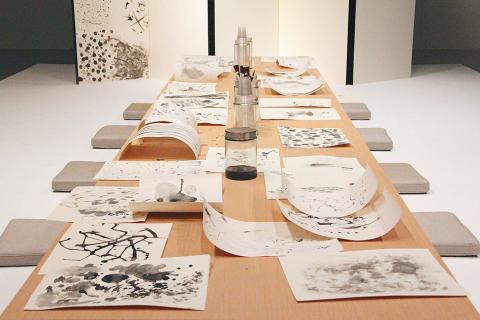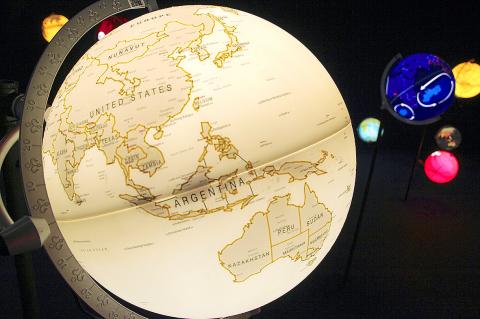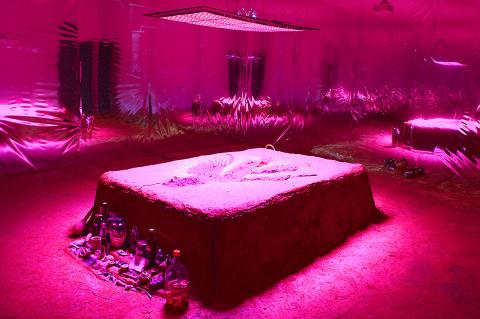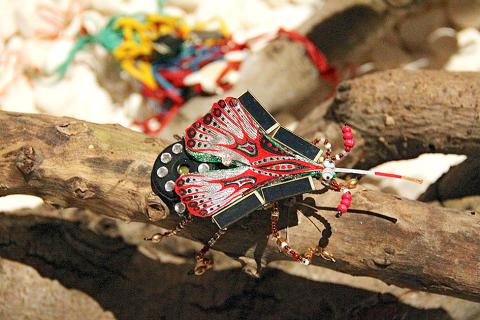If you thought action on climate change was dead, think again, because the artists, activists and scientists at this year’s Taipei Biennial have something to say.
That’s right — scientists. Over a third of the participants at the 11th edition of the Taipei Fine Arts Museum’s (TFAM) expansive exhibition are not artists in the traditional sense. Instead, they come from various circles including writing, filmmaking and non-governmental organizations. Most of them have hyphenated professions, and they have set up their journals, specimens and diagrams inside the museum.
Curated by artist Wu Mali (吳瑪利) and veteran Italian curator Francesco Manacorda, Post-Nature — A Museum as an Ecosystem (後自然:美術館作為一個生態系統) involves 42 individual and group participants and their personal explorations within the natural environment.

Photos: Sherry Hsiao, Taipei Times
Land of Hard Rain (苦雨之地) by Wu Ming-yi (吳明益) — whose novel The Stolen Bicycle (單車失竊記) was longlisted for the Man Booker International Prize this year — is a series of vintage-style scientific illustrations of plant and animal species that one might find in a cabinet of curiosities, which Wu drew to accompany his collection of short stories that shares the same name. Wu’s penstrokes are as poetic as his words. “To a tuna, not to swim is suicide,” he writes in one description. “Every tuna’s body is a massive symbol of the restless struggle for existence.”
One of the installations sure to be popular with both adults and children is the interactive Neo Eden — Solar Insects Vivarium (新伊甸園 — 太陽能昆蟲生態箱) by a team led by Professor Chen Chu-yin (陳珠櫻) from Paris 8 University’s Department of Arts and Technologies of Imagery. When you shine a flashlight on the bionic creatures, the solar panels on their backs trigger a noise that sounds partly like a metal detector and partly like a cricket. It was fascinating to see how easily people accepted an imitation of nature, and then jumped at the chance to control it with their battery-powered tools. If wires and electronic parts can replace insects, what could replace humans?
Next door, the sense of humans observing from on high heightens with Ingo Gunther’s Worldprocessor. Over 30 years, the artist-journalist-researcher has used hundreds of illuminated globes to map out everything from global wine consumption to migration to New York City. Gunther’s work appears to be a commentary on our need to analyze and categorize everything on our planet.

Photo: Sherry Hsiao,Taipei Times
Despite at times feeling like an aesthetically-charged science convention, the exhibition is at least as nostalgic and sensuous as it is analytical. In Scenery Near Yuanshan: Silence and Commotion beside the Keelung River (圓山附近:傾聽基隆河畔的寂靜與喧囂), Laila Fan (范欽慧), who founded the Soundscape Association of Taiwan in 2015, recreates the soundscape of Taipei’s Yuanshan area in 1928, when artist Kuo Hsueh-hu (郭雪湖) painted Scenery Near Yuanshan (圓山附近).
Perhaps the most intimate moment at the biennial is created by Zheng Bo’s (鄭波) Pteridophilia (蕨戀). Tucked away in the innermost room of the basement, the three-part video series explores the concept of “ecosexuality” with scenes of performers making love to ferns.
Of course, no discussion about the impact of human activity on the environment would be complete without addressing the exploitation of Aboriginal peoples and their land, past and present. The slogan “No one is an outsider” has since been adopted by advocates for other issues, but it originated from an ongoing protest against new government regulations that diminish Aboriginal land rights stipulated in the Indigenous Peoples Basic Act (原住民族基本法).

Photo: Sherry Hsiao, Taipei Times
A group of activists called the Indigenous Justice Classroom (原轉小教室) started the protest on Feb. 23 last year. Led by documentary filmmaker Mayaw Biho and musicians Panai Kusui and Nabu Husungan Istanda, they have been camping on the streets for over 600 days, first on Ketagalan Boulevard, then in front of the National Taiwan University Hospital MRT Station. Now, for the biennial, they have moved their fight — and their tents — into TFAM.
As is often the case at TFAM, the installation in the lobby serves as a centerpiece for the entire exhibition. All of the artists’ voices, in their various volumes and pitches, come together in Henrik Hakansson’s Inverted Tree (Reflected). Manacorda says that the message behind the hanging tree and the parallel mirrors is a simple yet powerful one — our actions today have consequences for the rest of eternity.
Walking through the Taipei Biennial is not unlike walking through a maze. If we have been cast out of nature through our own doing, the biennial is a way for us to find our way back. Through each encounter with an artwork, we reduce the emotional distance between ourselves and the environment.

Photo: Sherry Hsiao, Taipei Times
By using the term “post-nature,” the curators suggest that we are already living in an irreversible reality — but I am more optimistic. It is hard not to be, when you live on an island where you are never more than an hour away from a mountain.

The Taipei Times last week reported that the rising share of seniors in the population is reshaping the nation’s housing markets. According to data from the Ministry of the Interior, about 850,000 residences were occupied by elderly people in the first quarter, including 655,000 that housed only one resident. H&B Realty chief researcher Jessica Hsu (徐佳馨), quoted in the article, said that there is rising demand for elderly-friendly housing, including units with elevators, barrier-free layouts and proximity to healthcare services. Hsu and others cited in the article highlighted the changing family residential dynamics, as children no longer live with parents,

It is jarring how differently Taiwan’s politics is portrayed in the international press compared to the local Chinese-language press. Viewed from abroad, Taiwan is seen as a geopolitical hotspot, or “The Most Dangerous Place on Earth,” as the Economist once blazoned across their cover. Meanwhile, tasked with facing down those existential threats, Taiwan’s leaders are dying their hair pink. These include former president Tsai Ing-wen (蔡英文), Vice President Hsiao Bi-khim (蕭美琴) and Kaohsiung Mayor Chen Chi-mai (陳其邁), among others. They are demonstrating what big fans they are of South Korean K-pop sensations Blackpink ahead of their concerts this weekend in Kaohsiung.

Taiwan is one of the world’s greatest per-capita consumers of seafood. Whereas the average human is thought to eat around 20kg of seafood per year, each Taiwanese gets through 27kg to 35kg of ocean delicacies annually, depending on which source you find most credible. Given the ubiquity of dishes like oyster omelet (蚵仔煎) and milkfish soup (虱目魚湯), the higher estimate may well be correct. By global standards, let alone local consumption patterns, I’m not much of a seafood fan. It’s not just a matter of taste, although that’s part of it. What I’ve read about the environmental impact of the

Oct 20 to Oct 26 After a day of fighting, the Japanese Army’s Second Division was resting when a curious delegation of two Scotsmen and 19 Taiwanese approached their camp. It was Oct. 20, 1895, and the troops had reached Taiye Village (太爺庄) in today’s Hunei District (湖內), Kaohsiung, just 10km away from their final target of Tainan. Led by Presbyterian missionaries Thomas Barclay and Duncan Ferguson, the group informed the Japanese that resistance leader Liu Yung-fu (劉永福) had fled to China the previous night, leaving his Black Flag Army fighters behind and the city in chaos. On behalf of the